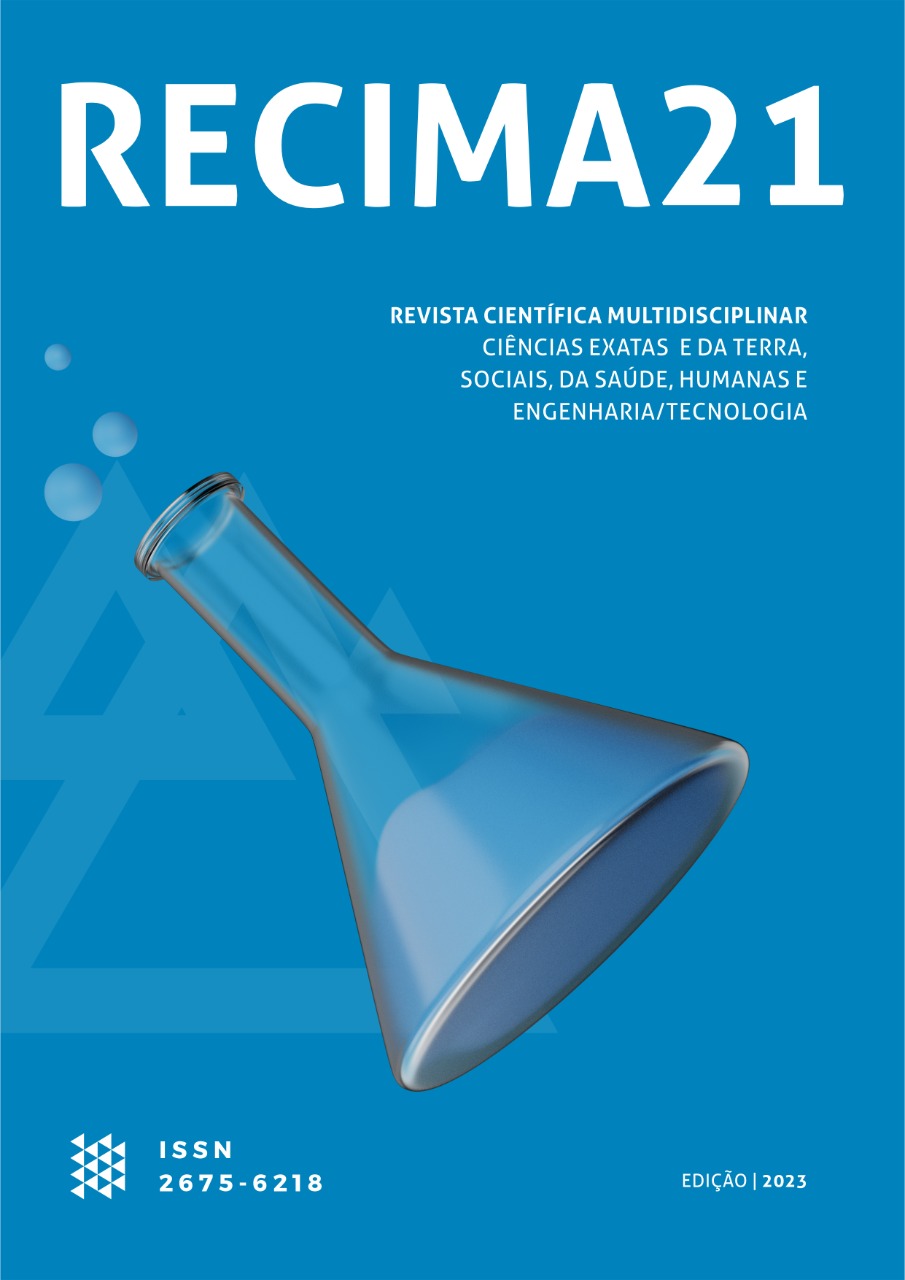ON THE FLORAL STRUCTURE AND COLLETERS AND THEIR BEARING ON THE SYSTEMATICS AND EVOLUTION IN SOME SPECIES OF RUBIACEAE
DOI:
https://doi.org/10.47820/recima21.v4i1.2612Palavras-chave:
Coléteres tipo standard, Mesofilo do perianto, Ovário ínfero apendicularResumo
The literature reveals that the tribes Psychotrieae and Spermacoceae (Rubiaceae) have problems delimiting genera and species and suggests the need for further studies, particularly of a morphological nature. In this context, the present investigation aims to study the floral structure and morphology of colleters of nine species from both tribes. The analysis was performed on flower buds and flowers of botanical material obtained from plants collected from different vegetation and from herbarium specimens. The samples were embedded in historesin and sectioned in a rotating microtome. The sepals exhibit a homogeneous or dorsiventral mesophyll. The petals, in general, have a homogeneous mesophyll. The colleters belong to the standard type, showing differences especially in the peduncle morphology. All species have compitum and can be considered eu-syncarpous. The ovary is inferior and exhibits basal placentation in Psychotrieae and axile placentation in Spermacoceae. Characters such as the absence of inverted vascular bundles in the ovary wall and ascending vascularization of the ovules indicate the appendicular nature of the ovary. Some characters related to the perianth, colleters and vasculature of the ovary wall and septum may be useful in separating the species. The type of placentation is a reliable character to separate Psychotrieae from Spermacoceae.
Downloads
Referências
ALMEIDA, O.J.G.; PAOLI, A.A.S.; SOUZA, L.A. Flower morpho-anatomy in Epiphyllum phyllanthus (Cactaceae). Revista Mexicana de Biodiversidad, v. 81, p. 65-80, 2010.
BREMER, B.; ERIKSSON, T. Time tree of Rubiaceae: phylogeny and dating the family, subfamilies, and tribes. International Journal of Plant Sciences, v. 170, n. 6, p. 766-793, 2009.
CARLQUIST, S. Toward acceptable evolutionary interpretations of floral anatomy. Phytomorphology, v. 19, p. 332-362, 1969.
COELHO, C.P.; BARBOSA, A.A.A. Biologia reprodutiva de Palicourea macrobotrys Ruiz & Pavon (Rubiaceae): um possível caso de homostilia no gênero Palicourea Aubl. Revista Brasileira de Botânica, v. 26, p. 403-413, 2003.
COELHO, C.P.; BARBOSA, A.A.A. Biologia reprodutiva de Psychotria poeppigiana Muell. Arg. (Rubiaceae) em mata de galeria. Acta Botanica Brasilica, v. 18, p. 481-489, 2004.
DELPRETE, P.G.; JARDIM, J.G. Systematics, taxonomy and floristics of Brazilian Rubiaceae: An overview about the current status and future challenges. Rodriguésia, v. 63, n.1, p. 101-128, 2012.
DICKISON, W.D. Integrative plant anatomy. San Diego: Harcourt Academic Press, 2000.
DOUGLAS, G.E. The inferior ovary. The Botanical Review, v. 10, p. 125-186, 1944.
ENDRESS, P.K. Diversity and evolutionary biology of tropical flowers. Cambridge: Cambridge University Press, 1994.
EVERT, R.F. Anatomia das plantas de Esau: meristemas, células e tecidos do corpo da planta: sua estrutura, função e desenvolvimento. São Paulo: Blucher, 2013.
GUERRITS, P.O. The application of glycolmethacrylate in histiotechnology: some fundamental principles - Gröningen, Netherlands: Department of Anatomy and Embryology, 1991.
JUDD, W. S., CAMPBELL, C. S., KELLOGG, E. A., STEVENS, P. F. Plant systematics - a phylogenetic approach. Sunderland: Sinauer Associates, 1999.
JUDKEVICH, M.D.; SALAS, R.M.; GONZALEZ, A.M. Colleters in American Spermacoceae genera (Rubiaceae): morphonatomical and evolutionary aspects. International Journal of Plant Science, v. 178, n. 5, p. 378–397, 2017.
LERSTEN, N.R. Morphology and distribution of colleters and cristals in relation to the taxonomy and bacterial leaf nodule symbiosis of Psychotria (Rubiaceae). American Journal of Botany, v. 61, p. 973-981, 1974a.
LERSTEN, N.R. Colleter morphology in Pavetta, Neorosea and Tricalysia (Rubiaceae) and its relationship to the bacterial leaf nodule symbiosis. Botanical Journal of Linnean Society, v. 69. p. 125-136. 1974b.
LERSTEN, N.R. Colleter types in Rubiaceae, especially in relation to the bacterial leaf nodule symbiosis. Botanical Journal of the Linnean Society, v. 71, n. 4, p. 311–319. 1975.
O’BRIEN, T.P.; FEDER, N.; MCCULLY, M.E. Polychromatic staining of plant cell walls by toluidine blue O. Protoplasma, v. 59, p. 368-373, 1964.
RAMOS, C.H. Estrutura da flor em gêneros de Spermacoceae sensu lato (Rubiaceae): contribuições para a taxonomia e filogenia. Dissertação de mestrado. Maringá: Universidade Estadual de Maringá, 2022.
ROTH, I. Fruits of angiosperms. In: K. Linsbauer (ed.). Encyclopedia of plant anatomy. Berlin: Gebrüder Borntrager, 1977. pp. 1–675.
SANTOS, A.F.; OLIVEIRA, A.C.; HARTHMAN, V.C.; ROMAGNOLO, M.B.; SOUZA, L.A. Can fruit ontogenetic features prove an important tool in the circumscription of Psychotrieae alliance? Australian Systematic Botany, v. 34, p. 527-540, 2021.
SMITH, F. H.; SMITH, E. C. Anatomy of the inferior ovary of Darbya. American Journal of Botany, v. 29, p. 464- 471, 1942.
SOUZA, L.A. Botânica estrutural: morfologia e anatomia de traqueófitas. Ponta Grossa: Editora UEPG, 2022. (in press)
SOUZA, L.A.; LEMOS, G.F.; BORTOLATTO, A.R.; OLIVEIRA, J.H.G. Flower structure and fruit ontogeny of Richardia brasiliensis Gomes and Diodia radula (Willd.) Cham. & Schltdl. (Rubiaceae). Revista Concilium, v. 22, n. 4, p. 867-874, 2022.
THOMAS, V. Structural, functional and phylogenetic aspects of the colleter. Annals of Botany, v. 68. p. 287-305. 1991.
VITARELLI, N.C.; SANTOS, M. Anatomia de estípulas e coléteres de Psychotria carthagenensis Jacq. (Rubiaceae). Acta Botanica Brasilica, v. 23, n. 4, p. 923-928, 2009.
WEBERLING, F. Morphology of flowers and inflorescences. Cambridge: Cambridge University Press, 1992.
Downloads
Publicado
Edição
Seção
Categorias
Licença
Copyright (c) 2023 RECIMA21 - Revista Científica Multidisciplinar - ISSN 2675-6218

Este trabalho está licenciado sob uma licença Creative Commons Attribution 4.0 International License.
Os direitos autorais dos artigos/resenhas/TCCs publicados pertecem à revista RECIMA21, e seguem o padrão Creative Commons (CC BY 4.0), permitindo a cópia ou reprodução, desde que cite a fonte e respeite os direitos dos autores e contenham menção aos mesmos nos créditos. Toda e qualquer obra publicada na revista, seu conteúdo é de responsabilidade dos autores, cabendo a RECIMA21 apenas ser o veículo de divulgação, seguindo os padrões nacionais e internacionais de publicação.













